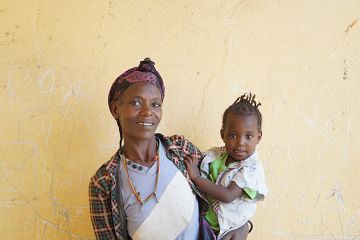Scaling up key interventions could halve pneumonia-related childhood mortality
13 February 2024New research finds that increasing the coverage of four pneumonia interventions to at least 90 percent from 2023 until 2030 could prevent half of the predicted deaths from pneumonia of children under five in Chad, Ethiopia and Bangladesh.

Increasing the coverage of four pneumonia interventions to at least 90 percent from 2023 until 2030 could prevent half of the predicted deaths from pneumonia of children under five in Chad, Ethiopia and Bangladesh, according to a prospective analysis carried out by a team from Malaria Consortium, other research organisations and government bodies. This equates to an estimated 97,343 lives saved in Ethiopia, 76,470 in Chad and 19,775 in Bangladesh.
Kevin Baker, study author and Malaria Consortium’s Senior Research Advisor, commented:
“Pneumonia continues to be the leading infectious cause of death in children under five. Malaria Consortium is committed to identifying gaps in treatment and prevention in key countries, and seeking ways to address these and improve pneumonia case management and associated childhood morbidity and mortality.”
Overall rates of under-five mortality in the three study countries are 29 per 1,000 live births for Bangladesh, 48 per 1,000 for Ethiopia and 110 per 1,000 for Chad. Pneumonia is responsible for 17 percent, 24 percent and 28 percent of these deaths, respectively. If the Sustainable Development Goal for child survival (SDG 3.2) of 25 deaths per 1,000 is to be achieved globally by 2030, it will be necessary to scale up effective interventions and to innovate to tackle pneumonia morbidity and mortality in the most-affected countries.
Using the Lives Saved Tool (LiST), a software package that models the impact of interventions on child and maternal mortality in low- and middle-income countries, the team evaluated the impact of increasing the coverage of four interventions that are proven to be effective against pneumonia: vaccination against Haemophilus influenzae B, pneumococcal conjugate vaccine (PCV), treatment with oral antibiotics and targeted oxygen treatment of hypoxaemia (low levels of oxygen in the blood, which is an important predictor of mortality).
By inputting estimates of the current use of the interventions in each of the three countries into LiST, the researchers were able to produce an estimate of the impact that upscaling each intervention would have on childhood mortality between 2023 and 2030.
Coverage of the interventions varies, as does the anticipated effect of upscaling each intervention. Chad currently does not include PCV in its national childhood immunisation programme, while Bangladesh immunises more than 90 percent of under-fives against pneumonia. Use of oral antibiotics, which was approximated from the number of children presenting to a health facility with symptoms of acute respiratory infection, appears to be low across all three countries. In Chad and Bangladesh, pulse oximetry devices (for measuring blood oxygen saturations) are not widely available and access to oxygen treatment is limited, while Ethiopia provides oxygen in all hospitals and a quarter of health centres.
Despite the lack of data, both on baseline coverage of the different interventions and on childhood mortality, this analysis clearly demonstrates the significant impact of increasing funding to tackle pneumonia-related mortality among under-fives in LMICs. In comparison with other infectious diseases, progress in reducing pneumonia deaths in children under five has been slow. Childhood pneumonia research has suffered from chronic underinvestment in recent years, receiving only three percent of the funding allocated to infectious disease research, despite being responsible for 13 percent of deaths in under-fives.
To increase and better target funding of childhood pneumonia research, Malaria Consortium developed the child pneumonia research investment scorecard with support from the Every Breath Counts Coalition. Out of 20 top research priorities identified by experts, 15 had fewer than 10 registered studies or awarded grants. Much of the research that is taking place globally focuses on new clinical tools and technologies, rather than operational research and health systems capacities.
Read more about research priorities highlighted in the child pneumonia research investment scorecard.
Related content
14 July 2023
Malaria Consortium Ethiopia
19 September 2023Review of childhood pneumonia research priorities to catalyse increased donor investment
14 November 2023Major gaps in childhood pneumonia research priorities remain
Latest news
- Malaria Consortium honoured by Ugandan government for contribution to combat malaria23rd April 2024
- International summit calls for AMR accountability in public health interventions21st March 2024
- Global SMC community celebrates new milestone at SMC Alliance Annual Meeting in Nigeria6th March 2024
- Scaling up key interventions could halve pneumonia-related childhood mortality13th February 2024
- Malaria Consortium and eGov Foundation join Mozambique’s national malaria programme to digitalise seasonal malaria chemoprevention campaigns8th February 2024
- World’s first malaria vaccine rollout launched in Cameroon22nd January 2024